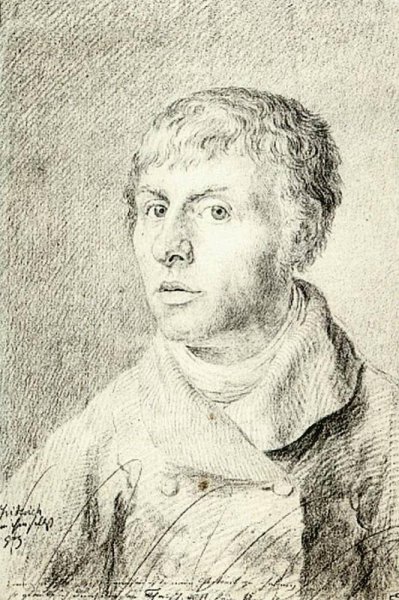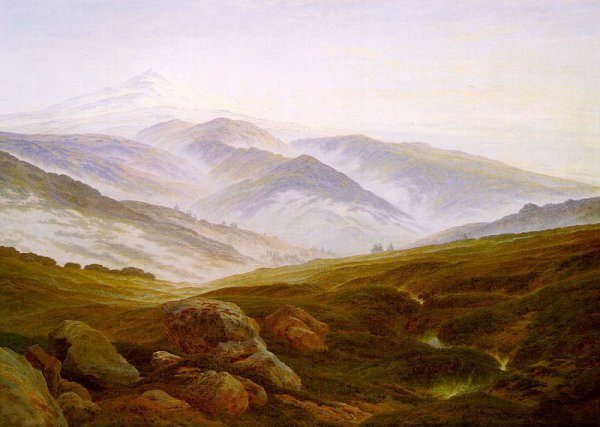Caspar David Friedrich Biography In Details
Early years

Caspar David Friedrich was born the sixth of ten children in Greifswald, Swedish Pomerania, on the Baltic Sea. He grew up under the strict Lutheran creed of his father Adolf Gottlieb, a prosperous candle-maker and soap boiler. Friedrich had an early familiarity with death: his mother, Sophie Dorothea Bechly, died in 1781 when Caspar David was just seven. At the age of thirteen, Caspar David witnessed his brother, Johann Christoffer, fall through the ice of a frozen lake and drown. Some accounts suggest that Johann Christoffer succumbed while trying to rescue Caspar David, who was also in danger on the ice. His sister Elisabeth died in 1782, while a second sister, Maria, succumbed to typhus in 1791.
Some of Friedrich's contemporaries attributed the melancholy in his art to these childhood events, yet it is as likely that Friedrich's personality was naturally so inclined. As an adult, the pale and withdrawn Friedrich reinforced the popular notion of the "taciturn man from the North". His letters, however, always contained humour and self-irony. In his autobiography, the natural philosopher Gotthilf Heinrich von Schubert wrote of Friedrich, "He was indeed a strange mixture of temperament, his moods ranging from the gravest seriousness to the gayest humour … But anyone who knew only this side of Friedrich's personality, namely his deep melancholic seriousness, only knew half the man. I have met few people who have such a gift for telling jokes and such a sense of fun as he did, providing that he was in the company of people he liked."
In 1790, Friedrich began to study art with Johann Gottfried Quistorp at the University of Greifswald, and literature and aesthetics with the Swedish professor Thomas Thorild. Thorild was interested in the contemporary English aesthetic, and taught Friedrich to distinguish between the spiritual 'inner eye' and the less favourable physical 'outer eye'. Friedrich entered the prestigious Academy of Copenhagen in 1794 where he studied under teachers such as Christian August Lorentzen and the landscape painter Jens Juel. These artists were inspired by the Sturm und Drang movement, and represented a midpoint between the dramatic intensity and expressive manner of the budding Romantic aesthetic and the by then waining neo-classical form. Mood was paramount, and influence was drawn from such sources as the Icelandic legend of Edda and Ossian, and Nordic folklore. A talented student, Friedrich began his education at the academy by making copies of casts from antique sculptures, before proceeding to drawing from life. He was keenly interested in seventeenth-century Dutch landscape painting, to which he had access at Copenhagen's Royal Picture Gallery.
In 1798 he settled permanently in Dresden. He often drew works, mainly naturalistic and topographical, with India ink, watercolor and sepia ink. It is unclear when he finally took up oil painting, but it was probably after the age of thirty. Landscapes were his preferred subject, inspired by frequent trips, beginning in 1801, to the Baltic coast, Bohemia, the Riesen Mountains and the Harz Mountains. Mostly based on the landscapes of northern Germany, his paintings depict woods, hills, harbors, morning mists and other light effects based on a close observation of nature. The paintings of this time were modeled on sketches and studies of scenic spots, like the cliffs on Rügen, and the surroundings of Dresden or Elbe. The studies themselves were made almost exclusively in pencil, and provided topographical information; the subtle atmospheric effects characteristic of Friedrich's maturity were rendered from memory. These effects would eventually be most concerned with the depiction of light, of the illumination of sun and moon on clouds and water, optical phenomena specific to the Baltic coast and that had never before been painted.
Maturity

Friedrich's first major painting came at the age of 34. The Cross in the Mountains, now known as the The Tetschen Altar (Gemäldegalerie, Dresden), was an altarpiece panel exhibited in 1808. The work met with controversy, but it was his first painting to gain wide appraisal; for the first time in Christian art, a pure landscape was the panel of an altarpiece. It depicts the crucified Christ in profile at the top of a mountain, alone, surrounded by nature. The cross rises highest in the composition, but is viewed obliquely and at a distance. The mountain symbolizes an immovable faith, while the fir trees represent hope. The artist and critic Basilius von Ramdohr published a lengthy article rejecting Friedrich's use of landscape in such a context; he wrote that it would be "a veritable presumption, if landscape painting were to sneak into the church and creep onto the altar". Rahmdohr was fundamentally asking whether a pure landscape painting could convey an explicit meaning.
Friedrich's friends publicly defended him, and the artist wrote a programme providing his interpretation of the picture. In his 1809 commentary on the painting, Friedrich compared the rays of the evening sun to the light of the Holy Father. That the sun is sinking suggests that the time when God reveals himself directly to man is past. Friedrich's extended interpretation of his own work was the first and last of its kind.
His recognition as an artist began with an 1805 prize at a Weimar competition. In 1810, Friedrich was elected a member of the Berlin Academy after the purchase of two of his paintings by the Prussian Crown Prince. Six years later he was elected a member of the Dresden Academy, a position which carried an annual stipend of 150 thalers. of the Setting Sun (c. 1818). 22 × 30 cm. After marriage, Friedrich incorporated larger figures into his canvasses.
On 21 January 1818, Friedrich, then 44, married Caroline Bommer. Bommer was twenty-five years old, the daughter of a dyer from Dresden, and a gentle, unassuming woman. The couple had three children, with their first, Emma, arriving in 1820. Carus noted that marriage did not change Friedrich's life or personality, yet his canvasses from this period have new levity. Female figures appear in his work, his palette is brighter, and the dominating symmetry and austerity are lessened. Chalk Cliffs on Rügen, painted after his honeymoon, is a good example of this development.
The artist found support from two sources in Russia. The Grand Duke Nikolai Pavlovich visited Friedrich's studio in 1820, returning to Saint Petersburg with paintings for his wife Alexandra Feodorovna. The poet Vasily Zhukovsky, tutor of heir to the throne Alexander II, met Friedrich in 1821 and found in him a kindred spirit. Over many years Zhukovsky helped Friedrich by purchasing his work and recommending his art to the royal family, especially at the end of Friedrich's career, by which time he was poor. Zhukovsky said that his friend's paintings "please us by their precision, each of them awakening a memory in our mind."
Friedrich was acquainted with Philipp Otto Runge, another leading German painter of the Romantic period, and gained the admiration of the poet Goethe. He was also a friend of Georg Friedrich Kersting, who painted him at work in his unadorned studio, and the Norwegian painter Johann Christian Dahl. Dahl was close to Friedrich during the artist's last years, and complained that to the art-buying public, Friedrich's pictures were only "curiosities". While the poet Zhukovsky appreciated Friedrich's psychological themes, Dahl attended to the descriptive quality of Friedrich's landscapes. Dahl said, "Artists and connoisseurs saw in Friedrich's art only a kind of mystic, because they themselves were only looking out for the mystic ... They did not see Friedrich's faithful and conscientious study of nature in everything he represented".
In June 1835, Friedrich suffered a stroke that caused some limb paralysis. He took a rest cure at Teplitz, but his ability to paint was greatly diminished. He worked only in watercolour and sepia, and symbols of death appeared heavily in his work, such as a sepia with an outsized owl perched on a grave in front of a full moon. By 1838, he was almost incapable of artistic work, lived in poverty, and was increasingly dependent on the charity of friends. His work was now considered anachronistic, and his death in May 1840 caused little stir in the artistic community. (From Wikipedia)




